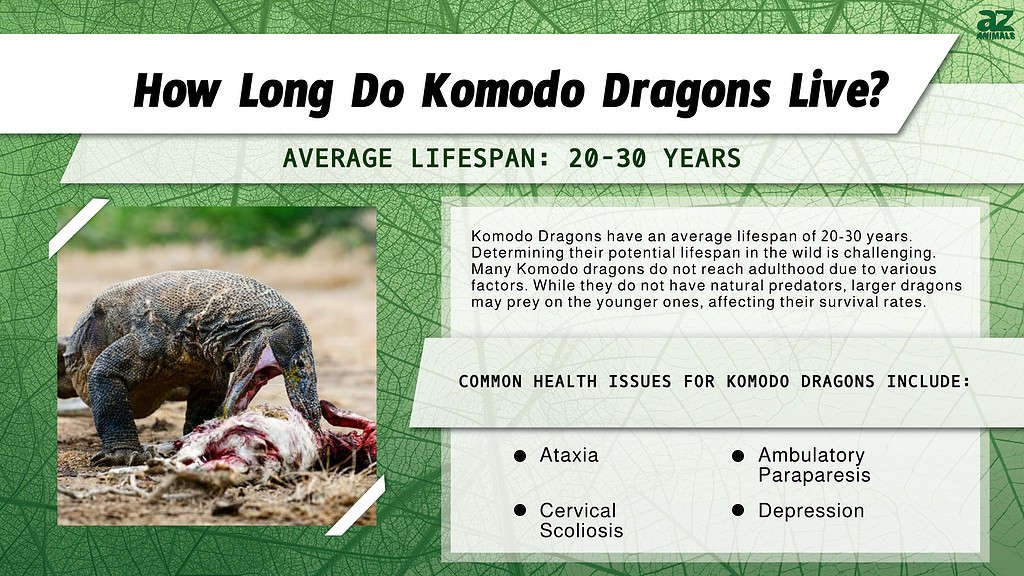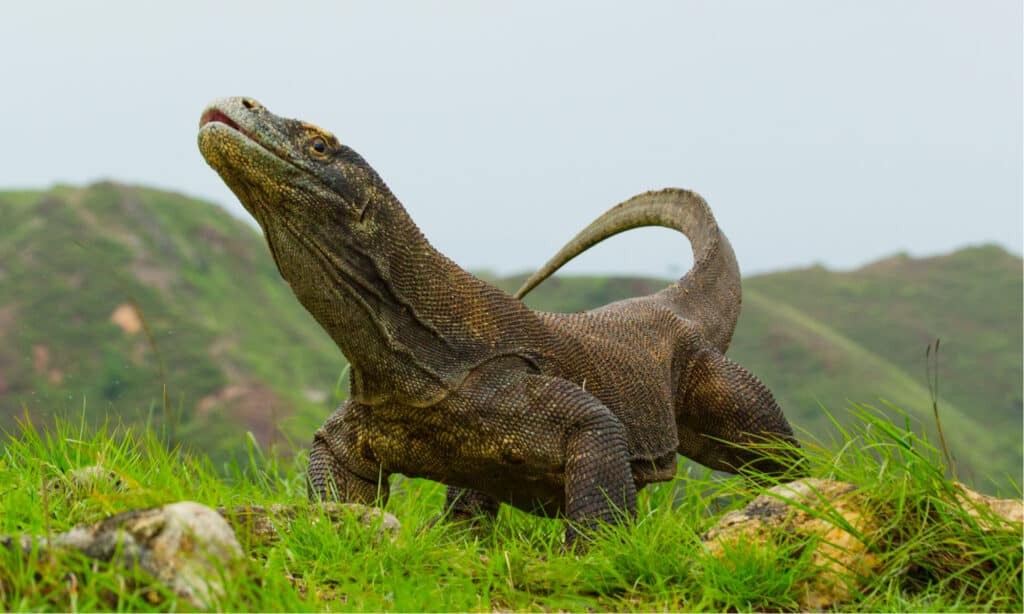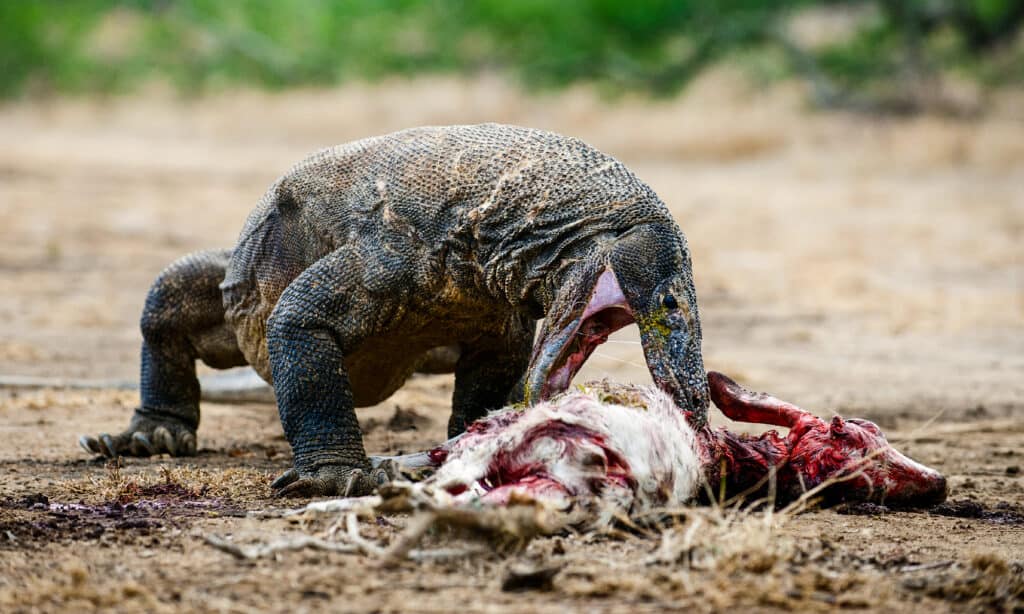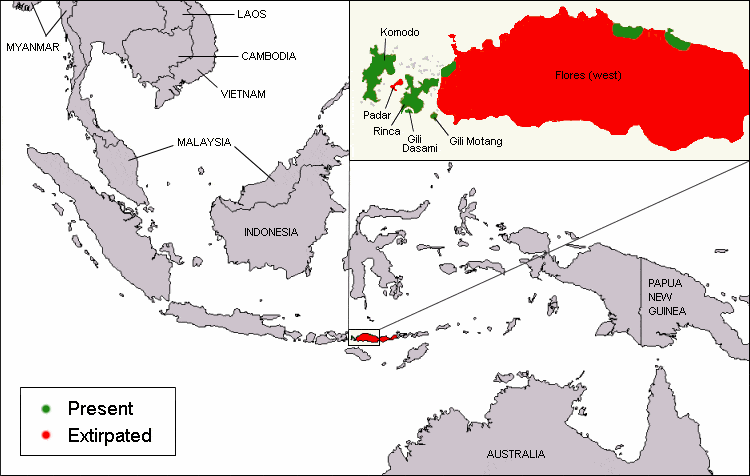
People are fascinated with big animals, and this is especially true of the Komodo dragon, the world’s largest lizard. Maybe it’s because they live on a few isolated islands in Indonesia. Most people don’t encounter them in daily life, so they’re an exotic novelty. Maybe it’s because they look like overgrown versions of the little lizards we may have seen in our yard. But probably one of the main attractions is that Komodo dragons look so much like living dinosaurs. Over the years biologists have learned more and more about these fascinating creatures, but surprisingly, one of the biggest remaining mysteries is the Komodo dragon lifespan. Just how long do they live, and why is it so hard to know for sure?

Does the Komodo dragon remind you of a dinosaur? Some people think so.
©GUDKOV ANDREY/Shutterstock.com
What is a Komodo Dragon?
How Big is It?
The first thing you notice about this animal is its size. They can get up to 8.5 feet long and weigh 200 pounds, on average. Maybe that doesn’t sound very big, because, after all, it is smaller than a female alligator. But think about this. The Komodo dragon is actually a kind of monitor lizard. And monitor lizards usually get to only 5 feet long and weigh about 15 pounds. So the Komodo dragon is noticeably bigger and heavier, like a pet on steroids. Just like their smaller cousins, they walk around on four short strong legs and use their long tails to swing back and forth and help them keep their balance as they walk and run. When chasing prey, it can run up to 13 miles per hour for short distances, and sometimes it throws up because it can run faster on an empty stomach.
How Does It Hunt?
A Komodo dragon uses its tongue to track prey. It waves a long, yellow, forked tongue to sample the air and then rubs it on a special detector organ inside its mouth. Depending on how strong the molecules are on one side of the tongue versus the other, it knows whether to move right or left to find food. Komodo dragons eat monkeys, goats, wild boars, deer, and even water buffalo. They also are fine with eating smaller dragons of their own species, which is why the babies spend the first few years of their life in the trees hiding from the adults.
When prey wanders past, the dragon lunges at it and delivers a venomous bite with its curved, serrated teeth. With larger prey, this usually isn’t enough to kill them, but the Komodo dragon has venomous and bacteria-filled saliva that prevents the blood from clotting and causes the animal to die in a few days from poison, infection, and blood loss. The dragon uses its sense of smell to track down the dead body up to 2.5 miles away. Multiple dragons may share the same kill.
Komodo dragons eat like snakes. They unhinge their jaws to gulp down gigantic hunks of meat. These lizards also have expandable stomachs that grow so big they can eat up to 80% of their own body weight at one time. The Komodo dragon doesn’t mind eating rotten meat. Dragons also eat the hooves, hides, and bones of their kill, and even the intestines, though they swing those around first to fling out the offal. These guys aren’t exactly someone you want to share a meal with!

Komodo dragons are carnivores, but not picky about what kind of meat they eat.
©Sergey Uryadnikov/Shutterstock.com
Where Does It Live?
Komodo dragons are lucky enough to live in Indonesia, a country with thousands of beautiful islands. But dragons have been found on only four islands named Rintja, Padar, Flores, and Komodo. Komodo itself is just 22 miles long, but it is the biggest of the four. Probably today we should be saying the dragons live on only three islands because unfortunately they haven’t been seen on Padar for at least 50 years. The islands have forests, open savannas, and nice beaches, and the dragons are equally at home in any of those habitats. They love hot, dry habitats. However, Komodo dragons can also swim and have been spotted quite far from shore. And you were worried about sharks . . .

Komodo dragons live on four islands in Indonesia, but they have not been spotted on the island of Padar for 50 years.
©Tommyknocker at en.wikipedia / Public domain – License
How Did the Komodo Dragon Get Its Name?
You can already guess that these reptiles were named after Komodo, one of the islands where they live. This was actually where Dutch explorers first saw them. Over time, sailors who had seen them embellished the story until the big monitor lizards of Komodo were said to be 23-foot-long flying dragons! With that kind of press, when some of these lizards were taken back to Europe and the United States, long lines would wind through zoos as people waited excitedly to see them.
Komodo Dragon Lifespan
When they are kept in a zoo, Komodo dragons can live 20-30 years. It’s tricky to say how long they could possibly live out in the wild though. First of all, a lot of them never make it to adulthood in the first place. They don’t have any natural predators, but the bigger dragons will eat the younger ones. As a result, the young try to keep themselves safe by staying up in the trees where the adults can’t follow them because they’re too heavy to climb. They will stay up there until they’re several feet long and can hold their own a little better. But one of the biggest reasons we don’t know how old they can get is that poachers and hunters have collected or killed so many of the bigger ones that we haven’t seen just how long they can live if they aren’t bothered.

Komodo dragons have venomous saliva but are immune to it themselves. Nevertheless, they will gladly eat their own species.
©Sergey Uryadnikov/Shutterstock.com
Can You Have Your Own Komodo Dragon?
It’s illegal to own a Komodo dragon because they are endangered, and because they are extremely dangerous. A large one can attack a person. Their venom is not deadly to people, but it creates swelling, and excruciating pain, and can give you a bad infection. If you were not able to get medical attention quickly, it would also be possible to bleed out from multiple bites and the anti-clotting properties of the toxin.
You can have the next best thing though. Why not have a pet monitor lizard, or, as we like to call it, a “miniature Komodo dragon!” Here’s a helpful guide to get you started: Pet Monitor Lizard Guide: What You Need to Know. However, even these require a great deal of space and care and are not recommended for beginning reptile owners. You might want to look for a smaller species, such as an iguana, chameleon, gecko, or others to get started.
Conservation Of Komodo Dragons
Believe it or not, Komodo dragons are so endangered there are only about 1,400 left living out in the wild. A lot of them have been killed by hunters who wanted to add an unusual exotic animal to their collections. Some have been collected alive as pets or as specimens for private collections. Komodo dragons are protected in the Komodo National Park. You can sponsor dragons through the World Wildlife Fund to help conserve the species. With a lot of people working together, maybe these unique animals will survive for future generations to enjoy.
The photo featured at the top of this post is © iStock.com/MikeLane45
Thank you for reading! Have some feedback for us? Contact the AZ Animals editorial team.






